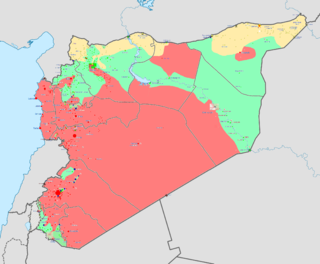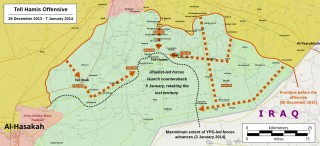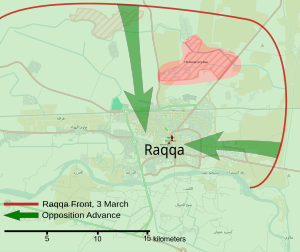Saraqib is a city in northwestern Syria, administratively belonging to the Idlib Governorate, located east of Idlib. During the course of the Syrian Civil War, the city fell into rebel forces in 2012 and was recaptured by the Syrian Army in 2020.
This is a broad timeline of the course of major events of the Syrian civil war. It only includes major territorial changes and attacks and does not include every event.

Harakat Ahrar al-Sham al-Islamiyya, commonly referred to as Ahrar al-Sham, is a coalition of multiple Islamist units that coalesced into a single brigade and later a division in order to fight against the Syrian Government led by Bashar al-Assad during the Syrian Civil War. Ahrar al-Sham was led by Hassan Aboud until his death in 2014. In July 2013, Ahrar al-Sham had 10,000 to 20,000 fighters, which at the time made it the second most powerful unit fighting against al-Assad, after the Free Syrian Army. It was the principal organization operating under the umbrella of the Syrian Islamic Front and was a major component of the Islamic Front. With an estimated 20,000 fighters in 2015, Ahrar al-Sham became the largest rebel group in Syria after the Free Syrian Army became less powerful. Ahrar al-Sham and Jaysh al-Islam are the main rebel groups supported by Turkey. On 18 February 2018, Ahrar al-Sham merged with the Nour al-Din al-Zenki Movement to form the Syrian Liberation Front.

The Ahfad al-Rasul Brigades was a Syrian rebel group fighting against the Syrian government in the Syrian Civil War. It was funded by the Qatari government.

Liwa Thuwar al-Raqqa was a rebel group in the Syrian Civil War. It was formed in September 2012 in the Raqqa Governorate. Aligned with jihadist factions for its first years, at the end of 2015, it joined the Syrian Democratic Forces. During an interview by Aymenn Jawad Al-Tamimi in 2015, Liwa Thuwar al-Raqqa's media director stated that the group wants a "civil democratic state". He also claimed that the group had no relations with the Syrian National Coalition based in Turkey.
The following is a timeline of the Syrian civil war from August to December 2014. Information about aggregated casualty counts is found at Casualties of the Syrian Civil War.
The Deir ez-Zor offensive was executed by the Islamic State of Iraq and the Levant, also known as ISIS, against all other opposition forces in the Deir ez-Zor Governorate as part of the Inter-rebel conflict during the Syrian Civil War.

The Battle of Idlib was a military operation in the Idlib Governorate, during the Syrian Civil War, conducted by rebels against Syrian government forces defending Idlib city.
The following is a timeline of the Syrian Civil War from January to July 2015. Information about aggregated casualty counts is found at Casualties of the Syrian Civil War.
The following is a timeline of the Syrian Civil War from January to July 2014. Information about aggregated casualty counts is found at Casualties of the Syrian Civil War.
The following is a timeline of the Syrian Civil War from January to April 2016. Information about aggregated casualty counts is found at Casualties of the Syrian Civil War.
The following is a timeline of the Syrian Civil War from May to August 2016. Information about aggregated casualty counts is found at Casualties of the Syrian Civil War.

The 2013 battle of Tell Abyad was a military confrontation in the town of Tell Abyad between the Kurdish Front and the Democratic Union Party-affiliated People's Protection Units and Women's Protection Units against the Islamic State of Iraq and the Levant, the al-Nusra Front, and Ahrar al-Sham, resulting in a Kurdish defeat and the jihadist capture of the town.

The Raqqa campaign (2012–2013) was a series of battles and offensives launched by various Syrian rebel groups, led by Ahrar al-Sham and the al-Nusra Front, against Syrian government forces in the Raqqa Governorate as part of the Syrian Civil War. The campaign was launched at the second half of 2012 and ended in the capture of the city of Raqqa as well as dozens of smaller towns and facilities.

The Battle of al-Yaarubiyah was fought in late October 2013 at al-Yaarubiyah, a strategically important town at the border of Syria with Iraq. Affiliates of the Democratic Union Party (PYD), namely the YPG/YPJ and local Arab tribes, attacked the settlement in an attempt to capture it from Jihadist and Islamist groups, led by the Al-Nusra Front and the Islamic State of Iraq and the Levant. After four days of heavy fighting, the Islamists were defeated and expelled from al-Yaarubiyah.

The al-Hasakah Governorate campaign was a multi-sided military conflict between Syrian government forces, Kurdish forces, armed Syrian opposition groups, and Salafist jihadist forces, including al-Qaeda's Islamic State of Iraq and the Levant and the al-Nusra Front in the al-Hasakah Governorate as part of the Syrian Civil War. The clashes began with the People's Protection Units (YPG)'s entrance into the civil war in July 2012 and spread across the governorate.

The Northern Democratic Brigade is a Free Syrian Army unit that is closely allied to the Syrian Kurdish YPG and YPJ in Afrin Region since 2014. Led by Absi Taha, Alexander Khalil, and Alexander Alaa, it also joined the Syrian Democratic Forces (SDF) in November 2015. The initial members of the group originated from Jabal Zawiya in Idlib, and it has recruited Arabs from Idlib, Aleppo, and other cities in northern Syria since allying with the YPG. Since joining the SDF, the unit has begun to operate across much of northern and eastern Syria, participating in operations against anti-SDF Syrian opposition factions, the Islamic State of Iraq and the Levant, the Turkish Armed Forces, and the Syrian National Army.

The Muntasir Billah Division, also known by its original name Muntasir Billah Brigade, is a predominantly ethnic Turkmen Free Syrian Army militia that has taken part in the Syrian Civil War. One of the most prominent pro-Turkish formations in the FSA, the group fought in the Battle of Aleppo (2012–2016) and other campaigns in Aleppo Governorate against the Syrian government, ISIL, and the SDF. The exact origin of the current Muntasir Billah Brigade is unclear, and it is possible that it originated as remnant of a rebel group that had been active in Raqqa Governorate until being subsumed by the al-Nusra Front and ISIL in 2013.
Opposition–ISIL conflict during the Syrian Civil War started after fighting erupted between Syrian opposition groups and the Islamic State of Iraq and the Levant (ISIL). In early January 2014, serious clashes between the groups erupted in the north of the country. Opposition groups near Aleppo attacked ISIL in two areas, Atarib and Anadan, which were both strongholds of the fundamentalist Sunni organization. Despite the conflict between ISIL and other rebels, one faction of ISIL has cooperated with the al-Nusra Front and the Green Battalion to combat Hezbollah in the Battle of Qalamoun. By 2018.

The Battle of Tell Hamis and Tell Brak was fought between the end of December 2013 and the start of January 2014 over control of the town of Tell Hamis and the village of Tell Brak in the al-Hasakah Governorate of northeast Syria during the Syrian Civil War. The armed wings of the Democratic Union Party (PYD), namely the People's and Women's Protection Units, in addition to the Syriac Union Party's Syriac Military Council (MFS), attempted to capture the areas from Salafist jihadists led by the Islamic State of Iraq and the Levant, the al-Nusra Front, and the Islamic Front's Ahrar al-Sham, but were repelled in a counter-offensive by the jihadists.












